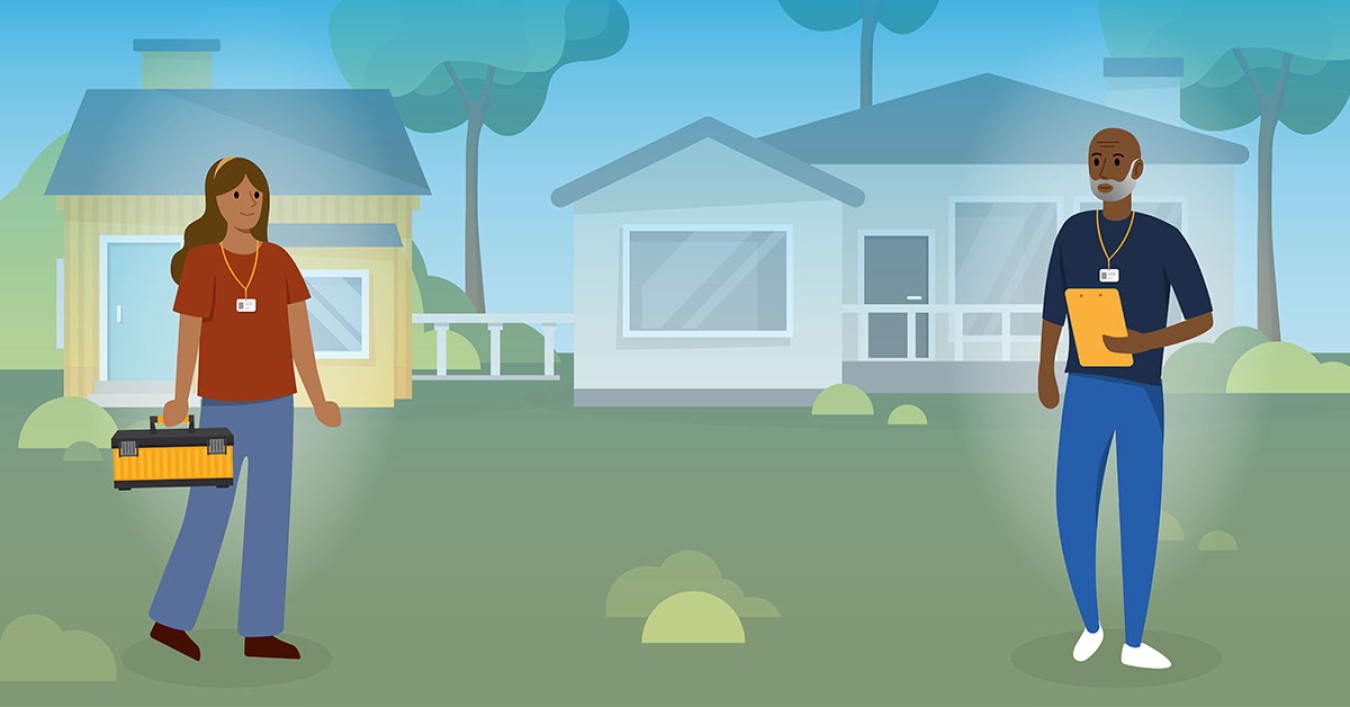Since 2015, Illinois has received $137.2 million from the Weatherization Assistance Program (WAP) and $17.6 million from the State Energy Program (SEP), resulting in the following benefits:

15,958 Homes Weatherized
Illinois reduced energy costs and improved health and safety in 15,958 homes.*

1,411 Jobs Created or Retained
The State Energy Program creates or retains one job for every $12,500 invested.*

Connected with 15,792 People About Energy Efficiency Installations
Illinois held 219 workshops, webinars, trainings, or outreach events since 2015.*
* Findings from a National Evaluation of the State Energy Program and a National Evaluation of the Weatherization Assistance Program.
States report outcomes of State Energy Program and Weatherization Assistance Program formula (annual) fund activities to DOE on a quarterly basis. The metrics above are outcomes of formula-funded activities since 2015.
The SCEP Project Map highlights the annual formula and competitive funding for WAP and SEP.
Illinois' State Energy Program at Work
Southern Illinois University Solar + Storage Project
The Southern Illinois University (SIU) Solar + Storage project is a scalable, replicable renewable energy system on the College of Engineering campus in Carbondale. The project consists of photovoltaic solar panels generating electricity and battery storage units functioning as an auxiliary power source during utility power disruption. The island mode of the Solar + Storage system allows for long-term evolution communication modules to sustain cellular communication for the SIU police department, the Carbondale police department, and the Carbondale fire department in the event of power disruption.
Public Water Infrastructure Energy Efficiency Program
Together with the Smart Energy Design Assistance Center (SEDAC) and Illinois Sustainable Technology Center (ISTC) at University of Illinois, the Illinois Environmental Protection Agency (EPA) Office of Energy is providing no-cost energy efficiency assessments to publicly-owned wastewater treatment plants (WWTP) and public water supply (PWS) facilities statewide. Since March 2018, a total of 108 WWTPs have been assessed and provided final energy assessment reports through the program resulting in the identification of 36.7 million kilowatt-hours (kWh) in annual energy savings and $3 million in cost savings. The final energy assessment reports identify opportunities for public water infrastructure facilities to implement energy, cost, and emission-saving improvements, while also improving the water treatment process.
In addition to funding energy efficiency assessments, the Illinois EPA Office of Energy awards competitive grant dollars to Illinois municipalities that have received an energy assessment within the previous 5-year period. The two grant opportunities to date, released in December 2018 and December 2019, resulted in grants totaling nearly $2.5 million of SEP funds to eight Illinois municipalities. Cumulatively, these projects will save more than 10 million kWh of energy and $555,910 annually.
Support for Local Governments and Building Trades
The Office of Energy and SEDAC at the University of Illinois have established an Energy Code Training and Technical Support Program to benefit Illinois building code officials and building industry professionals. The Illinois Energy Conservation Code (IECC) sets a standard for all commercial and residential buildings and protects the environment by reducing energy consumption, reducing air pollution, and stabilizing energy costs for buildings. The Energy Code Training and Technical Support program focuses on expanding energy code training to all areas of Illinois, especially those of high energy burden. A total of 23 in-person and 24 online workshops and trainings have educated over 4,392 construction and energy industry professionals. In addition, webinars and online, on-demand trainings have educated over 2,154 professionals.
Investment in New, Clean Energy Technologies
Established in 2016 with financial support from SEP, the Illinois Clean Energy Innovation Fund (Fund) is administered by the Clean Energy Trust (CET) in collaboration with the Illinois Environmental Protection Agency (EPA) Office of Energy to support innovative entrepreneurship and to create Illinois cleantech jobs. As an Illinois non-profit, CET works closely with the Illinois EPA Office of Energy to evolve and align the fund with the clean energy economy in Illinois and the Midwest. This is achieved with direct investments in high-potential, early-stage, Illinois-based cleantech companies.
The Illinois EPA Office of Energy re-asserted the state's role in the administration of the fund in SEP Program Year 2017 and continues to foster the partnership with CET—a partnership that provides critical grant funding to Illinois entrepreneurs through a revolving investment structure. To date, CET has invested nearly $3 million in 11 clean-energy businesses that currently employ 185 full-time employees.
Energy Curriculum for 5th & 6th Grade Students
The Illinois EPA Office of Energy is collaborating with the Illinois EPA Office of Environmental Education and the University of Illinois' Office for Mathematics, Science, and Technology Education to develop an energy-specific curriculum for Illinois 5th and 6th graders. The energy unit follows a storyline model allowing students to direct the lesson with their questions and focuses on energy generation, energy efficiency, and consumer energy choices. The curriculum aligns with Next Generation Science Standards for easy classroom use and will be available to nonformal educators. A tentative timeframe of Fall 2021 has been established to pilot the curriculum in several classrooms.
Learn more about SEP competitively awarded projects.
Learn more about SEP Implementation Models.
Illinois' Weatherization Assistance Program at Work
The Illinois Department of Commerce & Economic Opportunity is the managing agency for Illinois' Weatherization Assistance Program (IHWAP). The IHWAP contracts with local community action agencies and nonprofits to install weatherization improvements in low-income households throughout the state.
The IHWAP places heavy emphasis on providing citizens with comprehensive weatherization services; addressing all energy conservation and health and safety needs of a home, utilizing a true "house is a system" approach to each home and multifamily dwelling served.
The IHWAP is also equally as proud of the positive economic impacts provided by the program. The IHWAP is a leader in cultivating partnerships to strengthen economic development and workforce development in the state.
Between 2010 and 2021, Illinois weatherized an average of 1,893 homes per year with formula funds.
Success Stories
Read other SCEP News and Success Stories.
Illinois Takes Initiative
Better Buildings Initiative
More than 900 organizations are involved in the Better Buildings Initiative working to reduce energy and water waste and modernize the nation’s buildings and industrial facilities. Download the 2023 Better Buildings Progress Report for more information on the Initiative as a whole.
Better Buildings Challenge Partners
The city of Chicago, Cook and Will counties, Chicago Public Schools, and River Trails School District 26 have taken on the Better Buildings Challenge, a commitment to reduce the energy use of their entire building portfolios by 20% within 10 years and are making progress toward their energy reduction goals. As of 2021, public-sector Challenge partners have cumulatively saved 133 trillion Btus of energy, $1.27 billion, and 1.5 billion gallons of water since the Challenge was launched in 2011.
Better Climate Challenge
The U.S. Department of Energy (DOE) is challenging organizations to set ambitious, portfolio-wide GHG emission reduction goals. This new effort provides additional opportunities for peer exchange and technical assistance to meet the urgent call to mitigate the impacts of climate change.
River Trails School District 26 and Chicago Public Schools have joined the Better Climate Challenge, a commitment to reduce their portfolio-wide scope 1 and 2 GHG emissions by at least 50% within 10 years. They will pursue an energy efficiency target as part of this commitment, recognizing efficiency as a key driver of decarbonization.
Better Buildings Accelerators
In the past five years, SCEP has engaged nearly 100 partners in Better Buildings Accelerators. These Accelerators are designed to demonstrate specific innovative policies and approaches, which will accelerate investment in energy efficiency upon successful demonstration. Each Accelerator is a targeted, short-term, partner-focused activity designed to address persistent barriers that stand in the way of greater efficiency.
To learn more about other Better Buildings partners and solutions in the state of California and other states involved in the Better Buildings Initiative, check out the Better Buildings Partner map.
ESPC Accelerator Partners
The state of Illinois helped catalyze public-sector energy efficiency investments of over $2.1 billion in Energy Savings Performance Contracting (ESPC) from 2014–2016 as one of 25 state and local agency partners in the ESPC Accelerator. See demonstrated best practices in the ESPC Toolkit.
Outdoor Lighting Accelerator Partners
The city of Chicago, a partner in the Outdoor Lighting Accelerator (OLA) from 2014-2016, pledged to upgrade its streetlights as a part of a nationwide commitment to retrofit 1.3 million light poles with high performance lighting. These commitments are expected to result in annual savings of $48 million. See the Outdoor Lighting Toolkit for more information and demonstrated best practices.
Sustainable Wastewater of the Future (SWIFt) Initiative
The state of Illinois and city of Chicago committed to improving the energy efficiency of their participating water resource recovery facilities as part of the Sustainable Wastewater Infrastructure of the Future (SWIFt) Initiative Phase 1 from 2016-2019. SWIFt Phase 1 hosted 25 state, regional, and local agencies that engaged with more than 70 water resource recovery facilities in their jurisdictions and successfully reduced their total energy consumption by almost 7%, adopted best-practice energy management approaches showcased in the Wastewater Energy Management Toolkit, and created plans to achieve 30% energy savings.
The cities of Belvidere, Collinsville, East Peoria, Glenbard, and Wauconda committed to improving the energy efficiency of their participating water resource recovery facilities as part of the SWIFt Phase 2. SWIFt Phase 2 is engaging wastewater treatment facilities in a voluntarily partnership to achieve 5% short-term and 25% long-term facility-wide energy savings and implement at least one next-generation technology (e.g., renewable energy, resource recovery, and advanced data management).
Sustainable Corrections Infrastructure Partnership (SCIP) Accelerator
The state of Illinois is a participant in the Sustainable Corrections Infrastructure Partnership (SCIP) Accelerator, a voluntary partnership of state and local public correctional facilities working with DOE over three years (2021-2024) to achieve portfolio-wide energy and water savings of 20%, implement energy management systems, and create replicable solutions to catalyze energy resilience in the corrections sector. As of November 2021, SCIP had 17 partners consisting of 16 states and 1 county that represent almost 30% of state correctional facilities in the U.S.
Working Groups
C-PACE Working Group
The city of Chicago and Cook and Will counties, partners in DOE’s Commercial Property Assessed Clean Energy (C-PACE) Working Group, actively worked to develop or refine their C-PACE program with technical assistance from DOE, National Laboratories, and other subject matter experts. The C-PACE Working Group, which concluded in 2020, included more than 30 state and local participants working to learn about, launch, and refine C-PACE financing programs. Partners in the C-PACE Working Group achieved $70 million in C-PACE-financed investments in building upgrades. For more information, see the C-PACE Working Group.
Publications, Resources, Helpful Links
- State and Local Solution Center, a one-stop shop of impactful public-sector resources
- Weatherization Assistance Program
- State Energy Program
- NASEO State Energy Office Contact
- Contact State Weatherization Agency
- Illinois Implementation Model: Enhancing Energy Efficiency in the Public Sector
- EIA Illinois State Profile and Energy Estimates
- Chicago Better Buildings Challenge Partner Profile
- Cook County Better Buildings Challenge Partner Profile
- Will County Better Buildings Challenge Partner Profile
- River Trails School District 26 Better Buildings Challenge Partner Profile
